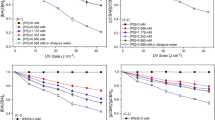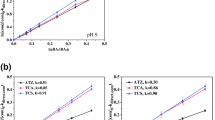Abstract
Microcystin-LR attracts attention due to its high toxicity, high concentration and high frequency. The removal characteristics of UV/H2O2 and O3/H2O2 advanced oxidation processes and their individual process for MC-LR were investigated and compared in this study. Both the removal efficiencies and rates of MC-LR as well as the biotoxicity of degradation products was analyzed. Results showed that the UV/H2O2 process and O3/H2O2 were effective methods to remove MC-LR from water, and they two performed better than UV-, O3-, H2O2-alone processes under the same conditions. The effects of UV intensity, H2O2 concentration and O3 concentration on the removal performance were explored. The synergistic effects between UV and H2O2, O3 and H2O2 were observed. UV dosage of 1800 mJ ·cm–2 was required to remove 90% of 100 mg·L–1 MC-LR, which amount significantly decreased to 500 mJ·cm–2 when 1.7 mg·L–1 H2O2 was added. 0.25 mg·L–1 O3, or 0.125 mg·L–1 O3 with 1.7 mg·L–1 H2O2 was needed to reach 90% removal efficiency. Furthermore, the biotoxicity results about these UV/H2O2, O3/H2O2 and O3-alone processes all present rising trends with oxidation degree of MC-LR. Biotoxicity of solution, equivalent to 0.01 mg·L–1 Zn2+, raised to 0.05 mg·L–1 Zn2+ after UV/H2O2 or O3/H2O2 reaction. This phenomenon may be attributed to the aldehydes and ketones with small molecular weight generated during reaction. Advice about the selection of MC-LR removal methods in real cases was provided.

Similar content being viewed by others
References
Wang N Y, Wang K, Wang C. Performance comparison of different algicides on growth of Microcystis aeruginosa and microcystin (MC)-LR release as well as the removal pathway of MC-LR in riverways. Frontiers of Environmental Science & Engineering, 2017, 11(6): 3–11
Sharma V K, Triantis T M, Antoniou M G, He X, Pelaez M, Han C, Song W, O’Shea K E, de la Cruz A A, Kaloudis T, Hiskia A, Dionysiou D D. Destruction of microcystins by conventional and advanced oxidation processes: A review. Separation and Purification Technology, 2012, 91: 3–17
WHO. Guidelines for Drinking-Water Quality, 2nd ed: addendum to volume 2—Health Criteria and Other Supporting Information. Geneva: World Health Organization, 1998, 95–110
Chang J, Chen Z L, Wang Z, Shen JM, Chen Q, Kang J, Yang L, Liu X W, Nie C X. Ozonation degradation of microcystin-LR in aqueous solution: Intermediates, byproducts and pathways. Water Research, 2014, 63(7): 52–61
Rositano J, Nicholson B C, Pieronne P. Destruction of cyanobacterial toxins by ozone. Ozone Science and Engineering, 1998, 20(3): 223–238
Al Momani F, Smith D W, Gamal El-Din M. Degradation of cyanobacteria toxin by advanced oxidation processes. Journal of Hazardous Materials, 2008, 150(2): 238–249
Park J A, Yang B, Park C, Choi J W, Genuchten C M V, Lee S H. Oxidation of microcystin-LR by the fenton process: Kinetics, degradation intermediates, water quality and toxicity assessment. Chemical Engineering Journal, 2016, 309: 339–348
Liu I, Lawton L A, Cornish B, Cornish B, Robertson P K J. Mechanistic and toxicity studies of the photocatalytic oxidation of microcystin-LR. Journal of Photochemistry and Photobiology A Chemistry, 2002, 148(1): 349–354
Wang C, Xi J Y, Hu H Y. Chemical identification and acute biotoxicity assessment of gaseous chlorobenzene photodegradation products. Chemosphere, 2008, 73(8): 1167–1171
Sun X, Wang C, Ji M. Production and release of microcystin-LR during treatment using chemical algicide. Fresenius Environmental Bulletin, 2017, 26(1A): 572–578
Wang C, Huang Y K, Zhao Q, Ji M. Treatment of secondary effluent using a three-dimensional electrode system: COD removal, biotoxicity assessment, and disinfection effects. Chemical Engineering Journal, 2014, 243: 1–6
Chang J, Chen Z L, Wang Z, Kang J, Chen Q, Lei Y, Shen J M. Oxidation of microcystin-LR in water by ozone combined with UV radiation: The removal and degradation pathway. Chemical Engineering Journal, 2015, 276: 97–105
He X, Pelaez M, Westrick J A, O’Shea K E, Hiskia A, Triantis T, Kaloudis T, Stefan M I, de la Cruz A A, Dionysiou D D. Efficient removal of microcystin-LR by UV-C/H2O2 in synthetic and natural water samples. Water Research, 2012, 46(5): 1501–1510
He X, de la Cruz A A, Hiskia A, Kaloudis T, O’Shea K, Dionysiou D D. Destruction of microcystins (cyanotoxins) by UV-254 nmbased direct photolysis and advanced oxidation processes (AOPs): Influence of variable amino acids on the degradation kinetics and reaction mechanisms. Water Research, 2015, 74: 227–238
Ren J. The inhibition mechanism and effect of UV/H2O2 process on Microcystis aeruginosa and its degradation mechanism to microcystin-LR. Dissertation for the Doctoral Degree. Shanghai: Fudan University, 2011 (in Chinese)
Lawton L A, Robertson P K J. Physico-chemical treatment methods for the removal of microcystins (cyanobacterial hepatotoxins) from potable waters. Chemical Society Reviews, 1999, 28(4): 217–224
Antoniou M G, Shoemaker J A, de la Cruz A A, Dionysiou D D. Unveiling new degradation intermediates/pathways from the photocatalytic degradation of microcystin-LR. Environmental Science & Technology, 2008, 42(23): 8877–8883
Song W, Xu T, Cooper W J, Dionysiou D D, De la Cruz A A, O’Shea K E. Radiolysis studies on the destruction of microcystin-LR in aqueous solution by hydroxyl radicals. Environmental Science & Technology, 2009, 43(5): 1487–1492
Hureiki L, Croué J P, Legube B, Dore M. Ozonation of amino acids: Ozone demand and aldehyde formation. Ozone Science and Engineering, 1998, 20(5): 381–402
Chang J. Study on degradation mechanisms of different oxidation methods based on removal of microcystin-LR in water. Dissertation for the Doctoral Degree. Harbin: Harbin Institute of Technology, 2015 (in Chinese)
Acknowledgments
This research was supported by Major Science and Technology Program for Water Pollution Control and Treatment in China (No. 2014ZX07203-009).
Author information
Authors and Affiliations
Corresponding author
Electronic supplementary material
Rights and permissions
About this article
Cite this article
Lu, S., Wang, N. & Wang, C. Oxidation and biotoxicity assessment of microcystin-LR using different AOPs based on UV, O3 and H2O2. Front. Environ. Sci. Eng. 12, 12 (2018). https://doi.org/10.1007/s11783-018-1030-2
Received:
Revised:
Accepted:
Published:
DOI: https://doi.org/10.1007/s11783-018-1030-2




